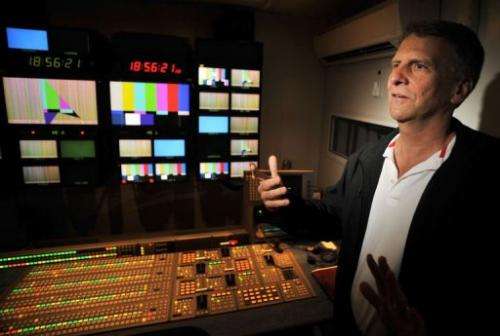Stan Honey, Director of Technology for the 2013 America's Cup, talks about the inner-workings of the control room before a media preview event of the America's Cup Park facilities in San Francisco on June 27, 2013.
YouTube, mobile applications, and the tech wizardry of veteran sailor Stan Honey are out to make America's Cup yacht racing as thrilling a spectator sport as Formula One.
Along with sailing 'in-shore' for the first time ever along courses on the picturesque San Francisco Bay, a sophisticated network of cameras, sensors and computers will make it simple to understand tactics playing out on the water.
"The venue is spectacular with the city and the Golden Gate Bridge; the boats are stunning in terms of speed and size, and then there is the technology," Honey said while taking AFP into America's Cup control rooms.
"The objective is for the technology to stay out of the way and yet allow the sport to be much more easily grasped."
It has been 15 years since Honey co-founded Sportvision, a company based on technology he developed to show television viewers the paths of hockey pucks, baseballs, and race cars, and US football first-down lines in real time.
Honey, who has sailed professionally since he graduated college decades ago, left Sportvision in 2004 to sail full time and was hired to navigate Larry Ellison's racing yacht Sayonara a year later.
But in 2010 after the billionaire yachtsman's boat won the America's Cup, he pulled Honey back into engineering.
"I mentioned to Larry what we were doing" with technology being used to enhance live sports feeds with graphics "and that sailing would be the perfect sport for it because there is a ton of stuff that is important and hard to see," Honey said.
Ellison was intent on making the 34th America's Cup in San Francisco a television-friendly event with spectator appeal beyond die-hard sailors.
Honey and his team wove cameras and sensors on catamarans, marker buoys, and a helicopter into a network for precisely tracking boats.
Data is shared between devices and with computers on shore, where real-time graphics in the form of lines on water are added to video to show boundaries; who is winning, and tactics being used by crews.
"Then it becomes easy to understand, and you give commentators a tool to tell a story," Honey said.
The team began testing the video graphics system in races in early 2010 and, in one case, it worked so well that viewers criticized the event for polluting water by putting colored trails behind the boats.
"We were flattered," Honey said.
— 'On board with the crew' —
Each AC72 catamaran competing in the Cup is fitted with six high-definition cameras remotely controlled from an operations room on shore
Crew members wear microphones, and additional microphones capture sounds such as winches being turned and water hitting hulls.
"We have had a mantra from when we first started: to present the sport from the inside out," said Cup television production executive Denis Harvey.
"As a viewer, we are taking you on board with the crew," he continued. "We see it as part of humanizing it and getting the viewer to see that it is pretty cool."
Cup umpires also get the benefit of using the boat-tracking technology and helicopter overhead view to make calls instead of having to rely solely on what is seen from chase boats.
Deals for television broadcasting of Cup races have been made in various countries, with NBC having rights in the United States.
Channels on globally popular Google-owned online video venue YouTube feature customized feeds showcasing favored aspects or teams. Nearly 49,000 people had subscribed to the America's Cup channel as of Friday.
"You're immersed in the action and can enjoy the sport more than ever, whether you're a new fan or a lifelong fan," YouTube global head of sports partnerships Claude Ruibal said of the Cup channel.
"On any device, you can watch live feeds from each boat with every sailor miked up and multiple cameras on the boats to capture the action."
Online viewing allows for customized and immersive viewing, along with letting people "time-shift" to watch when they want.
The Cup's technical team is also making real-time feeds of all race data—except video, because of broadcast rights deals—available free on a public "slave server" for smartphone or tablet application makers.
Applications using Cup data must be free.
One smartphone application allows spectators to stream position, speed and other details simply by aiming the handset at a particular AC72 catamaran from shore, Honey said.
"The spectator can also listen to on-board audio," Honey said of the application. "So, your phone feels like this amazing directional microphone because where ever you point it you can hear on-board audio."
Cup organizers vow the premier yacht-racing event will launch as planned here next week despite protests over last-minute rule changes triggered by the death of British sailor Andrew Simpson during training.
Racing is scheduled to start on July 7 in the Louis Vuitton Cup, the series of races that will produce the challenger to Oracle Team USA for the America's Cup races in September.
Team New Zealand, Italian syndicate Luna Rossa and Artemis Racing of Sweden are slated to compete.
© 2013 AFP





















